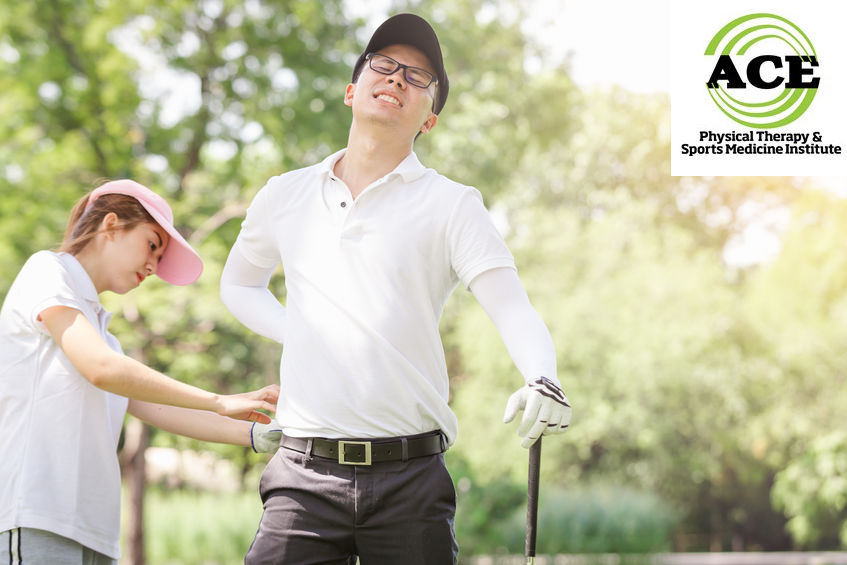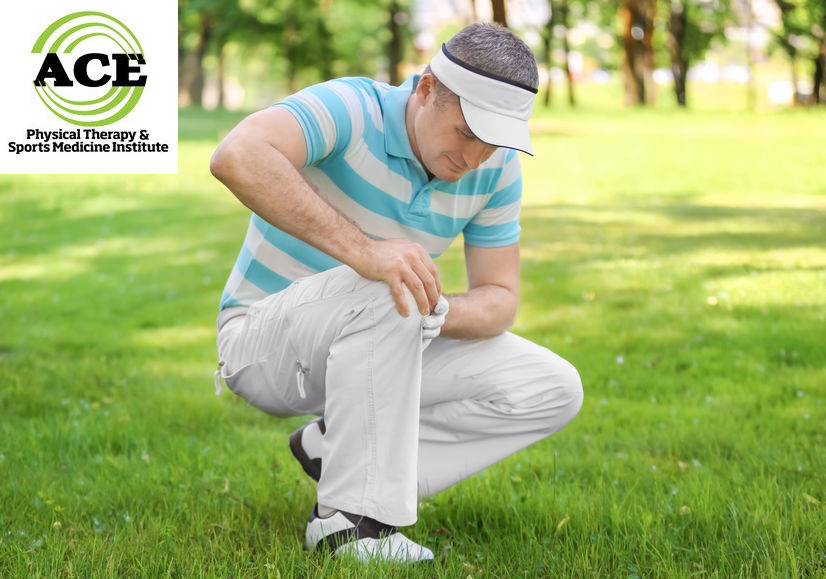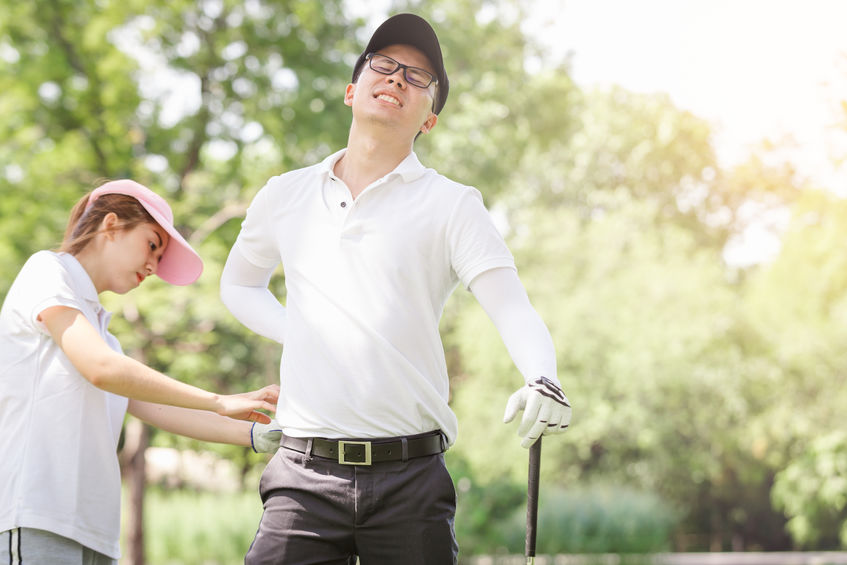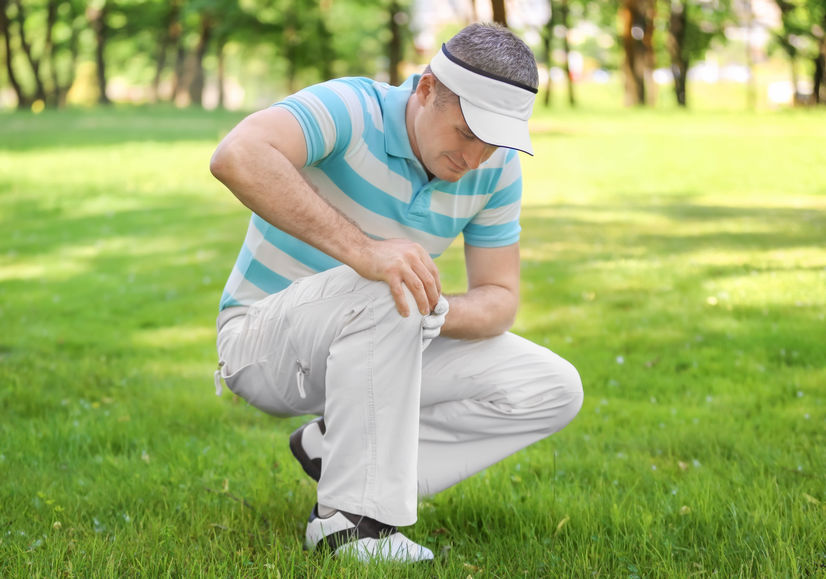GETTING FIT FOR GOLF

Tid Bits of Info
- A golfer can walk more than 10,000 steps and burn 2000 calories by simply “walking” a round of golf and “carry” the clubs.
- Club speed during a swing of an amateur averages between 70-80 mph and a professional 90-100 mph.
- Injuries rate can be as high as 40% for amateurs and 90% for professionals.
- Amateur golfers achieve approximately 90 percent of their peak muscular activity when driving a golf ball.
- Seek the advice of a Physical Therapist if you experience an injury during golf season or need tips on how to prepare for it.
Many golfers are just starting to get in the swing of things again. After a hiatus for several months, they are enjoying the warmer weather by getting back in the game. This is the perfect time to get fit for golf. While some players with a low handicap may enter the season in better shape and more prepared for time on the course, they may also face problems later in the season without proper preparation.
Playing golf requires that the body move in many ways to hit the ball. The segmental movements that occur every time the ball is hit are complex and can cause major injuries to nearly any part of the body if they are performed poorly or too many times in a given time period. A thorough fitness program may not improve your swing, but it should help you prevent injuries and reduce your overall game.
The golf swing has six phases, address, backswing, transition, downswing, impact and follow through and an injury can occur during any phase but the most common is the downswing. The specifics of a routine that can help will be published next week as the second part of this blog series on injury prevention during the golf swing. A well-rounded program prepares the whole body through strengthening and stretching exercises that will encompasses the entire musculoskeletal system.

Injuries in golf are very common and it does not matter if you are a professional or amateur. Some studies indicate that as many as 40% of all amateurs and 90% of professionals will experience some kind of injury during the upcoming season. The most common injuries occur to the lumbar spine in both amateurs and professionals. Amateurs tend to injure their upper extremity in all joints where the professional is more apt to hurt their wrists and hands. The lead side of the body, i.e. left side of a right handed golfer, is at least 5x more susceptible to suffering an injury when compared to the trail side.
Knowing that the entire body is involved in the golf swing, it would behoove all golfers to condition their entire body. Strength and flexibility programs have shown very positive results in producing a better golf game while experiencing fewer injuries. The golf swing is a series of stretch (load) and contract cycles throughout the musculoskeletal system.
Any conditioning program has to incorporate exercises that prepare the musculature for this type of activity or they are more prone to injuries. The program needs to place a large emphasis on lower extremity, hips and core strength. Exercises that strengthen the body in a straight line (squats, lunges) are fine but eventually the addition of drills and activities that incorporate twisting, turning and bending needs to occur. Performing a daily stretching program will improve flexibility. The type of stretching before playing should be dynamic which involves moving in a similar way that occurs during the actual event.
Seek the advice and treatment from a Physical Therapist for suggestions of specific exercises that will help you to get fit for golf, improve your game, and reduce the likelihood of injury while playing a round of golf. Personal trainers can monitor your routine throughout the season to help guide your progression of an exercise routine. These professionals can design specific gym work outs that focus on developing strength and flexibility throughout the musculoskeletal system which better prepares you for the upcoming season.
GETTING FIT FOR GOLF

Tid Bits of Info
- A golfer can walk more than 10,000 steps and burn 2000 calories by simply “walking” a round of golf and “carry” the clubs.
- Club speed, during a swing of an amateur, averages between 70-80 mph and a professional 90-100 mph.
- Injuries rate can be as high as 40% for amateurs and 90% for professionals.
- Amateur golfers achieve approximately 90 percent of their peak muscular activity when driving a golf ball.
- Seek the advice of a Physical Therapist if you experience an injury during golf season or need tips on how to prepare for it.
Many golfers are just starting to get in the swing of things again. After a hiatus for several months, they are enjoying the warmer weather by getting back in the game. This is the perfect time to get fit for golf. While some players with a low handicap may enter the season in better shape and more prepared for time on the course, they may also face problems later in the season without proper preparation.
Playing golf requires that the body moves in many ways to hit the ball. The segmental movements that occur every time the ball is hit are complex and can cause major injuries to nearly any part of the body if they are performed poorly or too many times in a given time period. A thorough fitness program may not improve your swing, but it should help you prevent injuries and reduce your overall game.
The golf swing has six phases, address, backswing, transition, downswing, impact and follow through and an injury can occur during any phase but the most common is the downswing. The specifics of a routine that can help will be published next week as the second part of this blog series on injury prevention during the golf swing. A well-rounded program prepares the whole body through strengthening and stretching exercises that will encompass the entire musculoskeletal system.
Injuries in golf are very common and it does not matter if you are a professional or amateur. Some studies indicate that as many as 40% of all amateurs and 90% of professionals will experience some kind of injury during the upcoming season. The most common injuries occur to the lumbar spine in both amateurs and professionals. Amateurs tend to injure their upper extremity in all joints where the professional is more apt to hurt their wrists and hands. The lead side of the body i.e. left side of a right-handed golfer, is at least 5x more susceptible to suffering an injury when compared to the trailside.
Knowing that the entire body is involved in the golf swing, it would behoove all golfers to condition their entire body. Strength and flexibility programs have shown very positive results in producing a better golf game while experiencing fewer injuries. The golf swing is a series of stretch (load) and contract cycles throughout the musculoskeletal system.

Any conditioning program has to incorporate exercises that prepare the musculature for this type of activity or they are more prone to injuries. The program needs to place a large emphasis on lower extremity, hips and core strength. Exercises that strengthen the body in a straight line (squats, lunges) are fine but eventually the addition of drills and activities that incorporate twisting, turning and bending needs to occur. Performing a daily stretching program will improve flexibility. The type of stretching before playing should be dynamic which involves moving in a similar way that occurs during the actual event.
Seek the advice and treatment from a Physical Therapist for suggestions of specific exercises that will help you to get fit for golf, improve your game, and reduce the likelihood of injury while playing a round of golf. Personal trainers can monitor your routine throughout the season to help guide your progression of an exercise routine. These professionals can design specific gym work outs that focus on developing strength and flexibility throughout the musculoskeletal system which better prepares you for the upcoming season.
























